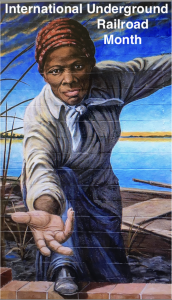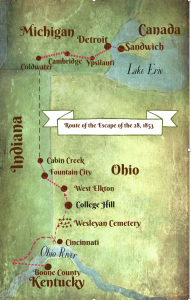Sedamsville’s abolitionist history
 On May 27, 2015 Ray Bushe, a local Price Hill and Sedamsville historian led a tour of River Road, for members of Hamilton Avenue Road To Freedom and colleagues from the Boone County Library. Sedamsville is of great interest to us as it was a stop for the “28” who in 1854 went north via College Hill and on to Canada. Our research indicates that they hid somewhere in the hills near there. Our Price Hill guide believes that the intended destination of the “28” was Rev. Horace F. Bushnell’s house or church, but when they did not find Rev. Bushnell, they rested in the hillside near his church, until they could reach help from the Cincinnati Vigilance Committee.
On May 27, 2015 Ray Bushe, a local Price Hill and Sedamsville historian led a tour of River Road, for members of Hamilton Avenue Road To Freedom and colleagues from the Boone County Library. Sedamsville is of great interest to us as it was a stop for the “28” who in 1854 went north via College Hill and on to Canada. Our research indicates that they hid somewhere in the hills near there. Our Price Hill guide believes that the intended destination of the “28” was Rev. Horace F. Bushnell’s house or church, but when they did not find Rev. Bushnell, they rested in the hillside near his church, until they could reach help from the Cincinnati Vigilance Committee.
Rev. Horace F. Bushnell, known as the blind preacher, was educated at the Oneida Institute, a Manual Labor School. He came to the West as the first student at Lane Seminary, where after graduation he taught English. Bushnell was the Hamilton County delegate along with Theodore Weld to the first convention of the Ohio Anti-Slavery Society in Putnam, Ohio, in 1835. He was initially ordained in the First Presbyterian Church. Eighteen years later he became a Congregationalist and pastored the Storr’s Congregational Church in Sedamsville. This was near a school built by his brother, Daniel, in Section 29 of Storr’s Township. Interestingly, Rev. Bushnell met and talked with Margaret Garner while she was in prison. Bushnell had a connection with College Hill: Rev. Bushnell’s son, Horace Bushnell, graduated from Farmers’ College in 1859.
Bushnell the elder was celebrated on the occasion of his 50th wedding anniversary, almost three decades after the ending of the institution of slavery, by friends from the abolitionist action days: the Cincinnati Daily Gazette carried an article reporting that the event was attended by, among others, Mrs. Reese E. Price, Katie Coffin, and Mary Jane Wilson Pyle and a letter was read from Theodore Weld.
From our walking tour we learned that Sedamsville was the home of several abolitionists – Rev. Horace F. Bushnell (not to be confused with another Rev. Horace Bushnell from Hartford, Ct.); Benjamin Bassett who lived near Mt. Echo off River Road; John Cleves Short, who purchased slaves to manumit them; Abraham Brower; Henry Ward Beecher, who owned property west of William Henry Harrison’s land; Evan and Reece E. Price (both R. E. Price and Bushnell had very unconventional views). Bushnell was a missionary to the Second Presbyterian Church in downtown Cincinnati. Evan Price, father of Reece E. Price, namesake of Price Hill, settled here. Salmon P. Chase also owned property here.
Sedamsville must have been a well known escape route. The Cincinnati Enquirer reported on April 20, 1855:
We learn upon a reliable authority, that within the past few days a number of slaves, from Kentucky, have escaped into this State, and are now on their way to Canada via the underground railroad. Four belonging to Harvy Williamson, of Union county, five belonging to Joseph Harris, of Bracken county, and two owned in Boone county. They came to this city, by taking passage on a float down Licking river, and thence to a point half a mile below Sedamsville, where they came on shore, and by the aid of friends in this State, they got off to Canada, Messes. Williamson and Harris were in the city yesterday in search of their slaves, and went up the railroad last evening in pursuit of them.”
Sedamsville, first named Sedams, is a community west of Cincinnati along the Ohio River that was important in river transport, the foundation of Cincinnati’s early economy. Strategically placed on the Ohio River, it was a good spot for the crossing of fugitives: safe hiding places on the land of the many nearby abolitionists, and the Whitewater Canal, opened in 1834, that facilitated the movement of people further west into Indiana, that is, unless they chose to move toward Cincinnati, as did the group of 28. The nearby Anderson Ferry was also sometimes used to transport freedom seekers across the Ohio.
Sect. 29 of Storr’s Township was the township’s designated ministerial section, which meant that this one mile square of land could not be sold, only leased, so that the rent monies would go to support the churches in that area. The people who built in Sedamsville would own their houses but not own the land upon which the houses stood. One of the first large landowners to lease in Sect. 29 was Ethan Stone, a lawyer, bank president, and politician. Stone was responsible for building the first bridge over the Mill Creek in 1811. It was a toll bridge, 120ft. long, costing $10,000. The bridge was swept away by the flood of 1822, obliterating Stone’s investment. The second bridge (non-toll) was purchased by the county. It also was destroyed by the 1845 flood. Stone moved away from Sedamsville in the 1830’s, which opened up his leased land in Section 29 to be subdivided and released. After Stone’s death a trust was set up to continue to collect rent. Over time , there was confusion about the property involved, which led to one of the longest running lawsuits in Hamilton County’s history—161 years!
August 6, 2015
Betty Ann Smiddy


